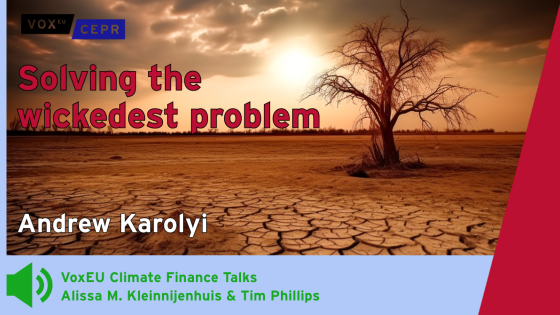The emerging members of the G20 are promoting the debate on global safety nets as a key topic for the next G20 meeting. While an international lender of last resort is more appealing to these countries than conditionality-heavy IMF-led packages, its practical advantages depend critically on a number of aspects that are sometimes downplayed in the policy discussion. Is the international-lender-of-last-resort agenda overdue or simply passé? And would the IMF ever play an effective role on this front?
Calls for an international lender of last resort gained momentum after the financial crises of the late 90s, when a number of emerging economies faced self-fulfilling liquidity runs rooted in currency mismatches and related balance sheet effects. The unwillingness of developed countries (and the IMF) to subscribe to the lender of last resort concept led emerging economies in Asia and Latin America to embrace a debt de-dollarisation and deleveraging strategy through the development of domestic markets and the buildup of a cushion of liquid international reserves – which largely explains why the sharp depreciations in 2008 and 2009 did not stress emerging market financial sectors as they used to in the 90s. In addition, partially as a reaction against the traditional IMF approach, the 2000s witnessed the strengthening of regional safety nets (typically in the form of bilateral central bank swaps agreements such as the Chiang Mai Initiative and the Latin American Reserve Fund).
Given these positive developments, do we still need an international lender of last resort? Even if one questions the view that self insurance in emerging markets contributed to the recent crisis (Allen and Carletti 2009)[1] , the crisis showed that, even in the absence of currency imbalances, financially globalised economies that benefited from downhill capital movements flows suffered from swings in global risk aversion and liquidity in the form of capital flight and excessive exchange-rate volatility[2]. In that context, access to foreign-currency liquidity proved useful in containing the domestic impact of these external shocks. In a de-dollarised emerging world, an international lender of last resort could still help manage excessively volatile capital flows.
What would be the advantage relative to self insurance?
Advocates usually highlight that, due to its potential diversification benefits, an international lender of last resort will require a smaller stock of low-yielding liquid assets than self insurance (or regional reserve pools). However, the high correlation risk of the systemic events the lender of last resort is intended for (namely, the fact all insured countries are likely to draw liquidity at the same time) should largely erode the diversification gains. Ultimately, in the event of a global liquidity crunch, only the issuer of liquidity could retain the systemic liquidity risk in good times without a hefty carrying cost – a logic that underscores the role played by the US Fed swaps during the crisis. If so, it is not the (arguably minor) diversification margin but the access to liquidity on demand that makes an lender of last resort more efficient than self insurance.
Can the IMF fill this role? Yes, subject to two conditions
- Firstly, the facility (a window available to pre-qualified countries to provide temporary foreign currency liquidity assistance at a small premium over pre-crisis levels) should be “incentive compatible”: only solvent countries should have access to it, and all eligible countries should profit from the facility (that is, they should be willing to tap it) in the event of a liquidity shock[3].
- Secondly, and perhaps more critically, agreements to borrow should provide the Fund with contingent liquidity without the need to hoard a costly liquidity buffer. This implies that major central banks should agree in advance to give “free access” to their balance sheets during a global liquidity crunch.
Liquidity insurance: Going through the menu
Liquidity insurance comprises a variety of policies that go from self insurance (the precautionary hoarding of reserves) to bilateral central bank currency swap agreements, including the various three-letter facilities launched by the IMF in recent years (such as the Contingent Credit Line and Flexible Credit Line).[4] Possibly in light of the only partial success of the Flexible Credit Line , the IMF has been exploring a number of possible enhancements, with the view to making the Flexible Credit Line more amenable to emerging clients[5].
Why have so few of the eligible countries requested the Flexible Credit Line?
While many of the possible answers go back to the post mortem of the old Contingent Credit Line, the experience with the Flexible Credit Line provided some new information. For starters, for all three takers (Colombia, Mexico, and Poland) the market reaction to a Flexible Credit Line application (none of them borrowed from it) was positive or, at worst, muted. If an IMF stigma is keeping clients away, its roots are more likely political than economic. On this, anecdotal evidence suggests that the need for IMF Board approval remains an obstacle. Waiving it through automatic pre-qualification (for example, in the context of the periodic Board discussions of Article IV consultations) could go a long way to increase the Flexible Credit Line appeal. Importantly, this automaticity should do away with the commitment fee, which would otherwise require the country to “accept” access, a move that, in addition to the political reluctance to pay for insurance in good times, often carries a costly political stigma.[6]
Would there be any advantage relative to bilateral central bank swaps? Yes, to the extent that it is made generous, free of political interference, available to a broader group of countries on a more predictable basis (e.g., by lengthening the Flexible Credit Line eligibility window to a rolling one-year period in correspondence with the Article IV consultation cycle), and with a clear procedure to sort out the exit problem (e.g., a transition to a light conditionality program) if the country´s liquidity problems evolve into a more permanent solvency issue.[7] Many of these aspects are currently being explored by the IMF (see Mateos y Lago et al., 2009), including the use of Maastricht-type pre-qualification criteria, the lengthening of the window from 6 to 12 months, the increase of the current access 10-quota cap, and the elimination of the Flexible Credit Line commitment fee – although the latter would require an amendment to the Articles of Agreement.
Who pays for this?
While the IMF has more than enough capital to deal with current commitments, an automatic, high-access liquidity window to cope with systemic shortages, if successful in eliciting members’ interest, it would likely demand important additions to the resource pool. Thus, the IMF seems to face a conundrum: current clients may not fully justify the latest resource injection, but they may need to go for more if they manage to make the facilities attractive to new clients.
Alternatively, one could conceive the IMF as a independent facilitator that manages existing and enhanced central bank swap agreements into one big liquidity network for eligible countries, and stands ready to step in with traditional programmes if liquidity fails to cure the patient. Perhaps it is as a “central bank swap clearing house” (an intermediary for central bank liquidity) that the IMF can finally make a decisive contribution for its more advanced clients.
References
Allen, Franklin and Elena Carletti (2009), “The Global financial crisis”, Paper presented at the 13th Annual Conference of the Central Bank of Chile.
Caballero, Ricardo and Stavros Panageas (2005), “A Quantitative Model of Sudden Stops and External Liquidity Management”, NBER Working Paper 11293
Cordella, Tito and Eduardo Levy-Yeyati (2005), “The case for an IMF Insurance Facility”, in Reforming the IMF for the 21st Century, Special Report 19, IIE.
Cordella, Tito and Eduardo Levy-Yeyati (2006), “A (New) Country Insurance Facility”, International Finance, 9:1-36
Kenen, Peter B (2007), “IMF reform: a marathon, not a sprint”, VoxEU.org, 30 October.
Mateos y Lago, Isabelle, Rupa Duttagupta and Rishi Goyal (2009), “The Debate on the International Monetary System”, IMF Staff Position Note 09/26.
Ostry, Jonathan and Jeromin Zettelmeyer (2005), “Strengthening IMF Crisis Prevention”, IMF Working Paper 05/206.
World Bank (2007), Country Insurance: Reducing Systemic Vulnerabilities in LAC, A Regional Study by Issam Abousleiman, Cesar Calderon, Tito Cordella, and Eduardo Levy Yeyati.
[1] In particular, it is difficult to attribute the recent accumulation of reserves in China, Japan and oil exporting countries (which accounts for the bulk of global imbalances) to a precautionary motive, as this view implies.
[2] Note that, while in the 2000s foreign exposure (typically through unhedged positions in local equity and fixed income markets) no longer entails a currency mismatch, a capital reversal could still trigger a costly liquidity crunch.
[3] Eligibility criteria geared towards assessing the country´s solvency should take into account currency mismatches so as to offset the perverse incentives to borrow in foreign currency introduced by the international lender of last resort’s implicit currency guarantee. (See Cordella-Levy Yeyati 2006 and Ostry-Zettelmeyer 2005).
[4] This contrasts with many proposals usually treated within under the same umbrella but closer to traditional insurance schemes that entail a state-contingent transfer (from the country to the insurer in good times and from the insurer to the country in bad times), such as catastrophe insurance (as in the World Bank´s Caribbean Catastrophe Risk Insurance Facility, or the use of CAT bonds by sovereigns to insure against natural disasters as recently in Mexico, see World Bank 2007) and hedging through derivatives (Caballero and Panageas 2005 or the recent Mexican oil hedges).
[5] This goes in parallel with various blueprints for FX liquidity insurance being considered within the G20 working group on global safety nets.
[6] These ideas have been part of the debate on the IMF reform for some time. (See, e.g., Cordella-Levy Yeyati 2005, and Kenen 2007).
[7] By contrast, rules-based eligibility may be hard to implement on a regional basis. In the Eurozone, it goes against the ECB rules; in Asia, above the 20 percent limit, eligibility is outsourced through an IMF program; and FED swaps partners during the crisis were selected somewhat arbitrarily based on US domestic concerns.



